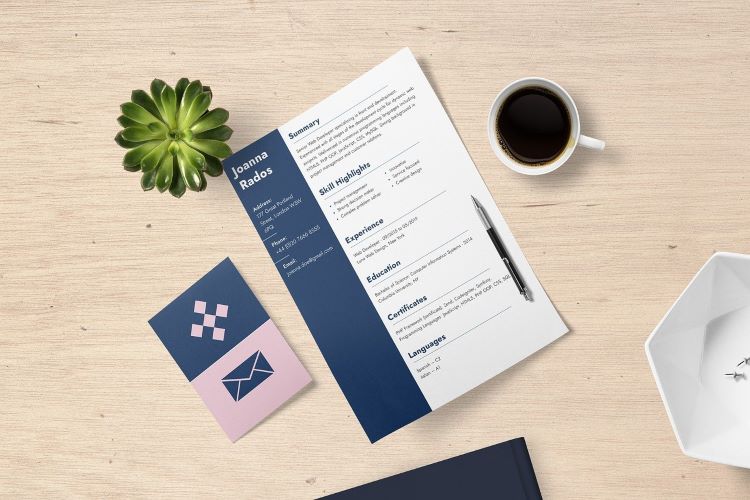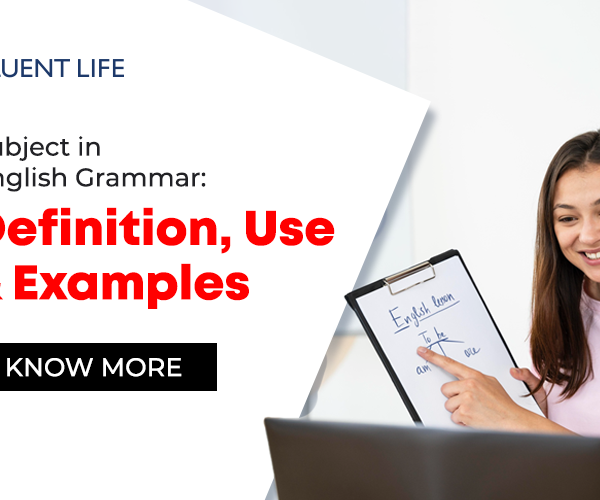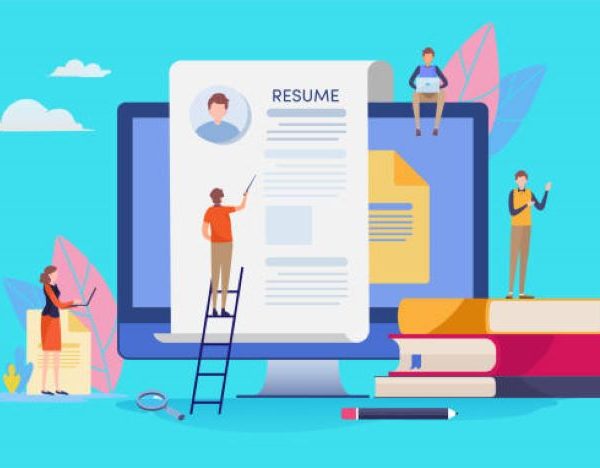When a person transitions from academic to professional life, he or she frequently needs to have a CV, resume, or biodata with them. Not only that, but this piece of paper necessitates numerous updates and verifications over time.
Wait! What!? Was there anything in particular that got repeated three times? Were that CV, Resume, and Biodata you were looking for?
Right! However, all three terms relate to the same piece of paper. Isn’t that so?
Well, here’s a twist on your knowledge: these three words may refer to the same item of a document in part, but they are not the same thing in total. So, before we go any further, let us first introduce you to these terminologies.
Also Read: How to Talk to Anyone? Let’s Check Out the Spoken English Information!
Difference Between CV Resume and Biodata
| Properties while
comparing |
Biodata | Resume | CV |
| Meaning | In the past, it was used to cover a person’s personal information. | Saturated and precise job profile of a person | A full description of the person, as well as the job profile they have achieved |
| Length | Not more than 1-page | Maximum 2 pages | May, vary(generally 4-5 pages) |
| Key focus | Personal information | Educational details and past job details | Detailed personal, educational, co-curricular, and past job profile handling information |
| When to use | Applying for govt. Posts or marriage proposals | Job seeking profiles or a fresh job | Fellowship, internship, higher job posts |
| Document type | Concise | Concise | Comprehensive |
| Educational details | At the bottom | In between | At the top |
| Ordered chronology | Not needed | Not needed | Needed |
| Structure | Very personal, simple and detail-oriented | Sticking to educational details and abilities while keeping it brief and precise too | Mentioning the complete history of a person(educational, qualitative, personal, and job-skill details) |
| Reference | May vary | Not included | included |
CV Format
Your CV is longer than a resume, usually 2 to 3 pages long, or perhaps longer depending on the situation. In chronological sequence, a C.V. lists every skill, all employment and positions held, degrees, and professional connections the candidate has obtained.
A CV is designed to highlight a candidate’s overall talent rather than specialised skills for a particular post. CVs cover your whole job history since graduation. If you have 20 years of experience, your CV will include information from all of those years, even if it means a 10-page paper.
Also Read: English Conversation between Teacher and Student: Essential Tips to Start a Conversation
CV Format Requirements
#There is no page limit.
#Important KRAs or OKRs from the entire tenure are listed, as well as all abilities and certificates (also expired)
#Adapted for a broader readership rather than a specific job description
#Written in the first, third, or neutral person
#The Most Critical Information: Full name, brief bio, contact information, education information, professional skills and certifications, work experience in chronological order, interests, courses, publications, and references
#It is not necessary to add nationality, birth date, gender, interests, father’s name, and declaration.
CV Format Example
#Contact Information.
#Personal Statement.
#Professional Experience.
#Academic History.
#Key Skills and Qualifications.
#Industry Awards.
#Professional Certifications.
#Publications.
#Professional Affiliations.
#Conferences Attended.
#Additional Training.
Resume Format Examples
When applying for a new job, a resume is ideally an overview of one’s education, talents, and work experience. A CV does not describe all of the characteristics of a profile; rather, it focuses on a few key talents that are tailored to the target job profile. As a result, it is usually one or two pages long. To give it an objective and formal tone, a resume is frequently written in the third person.
In reverse chronological sequence, an excellent resume would begin with a brief profile of the candidate, followed by a summary of industry expertise, qualifications, and professional experience.
The emphasis is on recent experiences (with successes and responsibilities), whereas older experiences are only summarised. Professional Affiliations, education, and/or Voluntary Initiatives would be listed after that.
Also Read: English Conversation Between Strangers: Tips to Start a Conversation with a Stranger
Resume Format Requirements
#Maximum of 1 or 2 pages
#Only relevant and active certifications are listed in this list of important KRAs or OKRs from the last ten years.
#Adapted to a specific job description
#Written in the third person or a neutral tone
#The Most Critical Information: Full name, professional skills and certifications, reverse-chronological experience, contact information, and education information
#It is not necessary to add nationality, birth date, gender, interests, father’s name, and declaration
How to Format a Resume?
#On all four sides, leave a one-inch margin.
#Choose a resume font size of 11 or 12 points and stick with it.
#Make sure your contact information is properly formatted in the resume header.
#Divide your resume into sections that are easy to read: Contact information, education, resume summary, work experience, and skills are all listed on the resume.
#To discuss previous occupations, use bullet points.
#Maintain consistency in your resume layout (use the same date format, such as 12–2018 or December 2018).
#Use a single line spacing or 1.15 line spacing.
#Extra space should be added before and after each section heading.
#Create a resume that is as long as you need it to be.
#On your CV, avoid using photos. Unless the job description clearly states that they are required. You’re not looking for a date; you’re looking for a job!
Resume Chronological Order: Pros and Cons
| Pros | Cons |
| It is well-known among recruiters. They’ll know where your information is and that you’ve provided a complete resume automatically. | It will need to be tweaked. To capture the recruiter’s attention, you’ll have to put in some extra effort. |
| It will undoubtedly pass an Applicant Tracking Software (ATS) resume test. | Recruiters will readily notice major gaps in your employment history if you have them. |
| The reverse chronological resume structure emphasises your career-high points. | It’s not the best CV structure for career changes. |
Biodata Format Examples
Biodatas are no longer utilised in a career-oriented field because it is an obsolete phrase. When our parents went for interviews in the 1970s, they used to share their biodata. Nowadays, Biodata is usually used as a reference in arranged (or love) weddings where the other party’s parents request it.
Personal details such as religion, date of birth, gender, race, domicile, marital status, nationality, and so on are the subject of a biodata. After that, there is a chronological listing of education and experience, however, this is merely to display what a person has done, not to find a job.
It may be used in place of a resume in various South Asian nations (for example, Bangladesh). When applying for government or defence posts, a biodata form is also required.
Requirements
#There is no page limit.
#Date and time of birth, nationality, gender, ethnicity, religion, residence and marital status are all important factors to consider.
#Designed just for weddings
#Written in a first-person or third-person perspective
#Education and experience are not required.
#If used for marital purposes, salary details are required.
Writing a Summary
Make sure to include the following in your biodata summary to make it a winner:
#It concentrates on your track record.
#Indicates your level of education and/or experience.
#It demonstrates your accomplishment(s).
#Quantifies what’s possible with numbers.
If you truly want to make your biodata format stand out, having an opening statement could be a game-changer. Make sure your objective highlights your strongest qualities, incorporates relevant experience and demonstrates how you can help the firm.
A summary is similar to a resume in that it is only a few phrases long, but it gives the company some insight into your experience that suits their needs.
Personal Information
Unlike the preceding portion, this one does not allow for much creativity. But that doesn’t mean you should disregard it or make it boring! No. Make certain to include all pertinent details.
Check the job posting to determine if any specific instructions must be followed. Here are some examples of what you might wish to add in the personal information part of your biodata:
#Current position
#Phone number
#Email address
#Contact details
#Place of residence
#Postal address
#Date of birth
#Nationality
#Marital status
#Parents’ names
#Gender
#Religion
#Height
#Complexion
#Race
#Salary
#Hobbies
#Interests
#Strengths
#Character traits.
Also Read: English Conversation Chat: Check Out the Conversation Ways with a New Employee!
Prove Your Experience
This is where you organise your work experience by date.
But pay attention: don’t merely include the names of the companies where you worked.
There’s a lot more to it than that!
Take a close look at the job posting itself first. Does it resemble it at all?
Design, building, and maintaining applications for a variety of devices is part of the job description. Make sure your code is testable and well-designed. Adding additional functionality to existing code. The idea is to personalise your biodata to a specific job offer and demonstrate the abilities and expertise the recruiter is looking for.
Conclusion
Hopefully, the difference in the above article was clear. You should know that some companies may ask only for your resume, but if you go west, they will surely ask about your CV along with your resume and sometimes biodata.
To the employer, including the most relevant education, experiences, accomplishments, and talents. You can discover the most important features by carefully reading the job advertisement. Important information should be prioritised on your resume to draw attention to key skills and accomplishments.
You also have the choice to download the Fluent Life app on your mobile phone for customized personal lectures where you get instant feedback on your performance and can resolve all your queries.
Also Read: Things Your Resume Must Have: Essential Writing Tips to Land a Job






